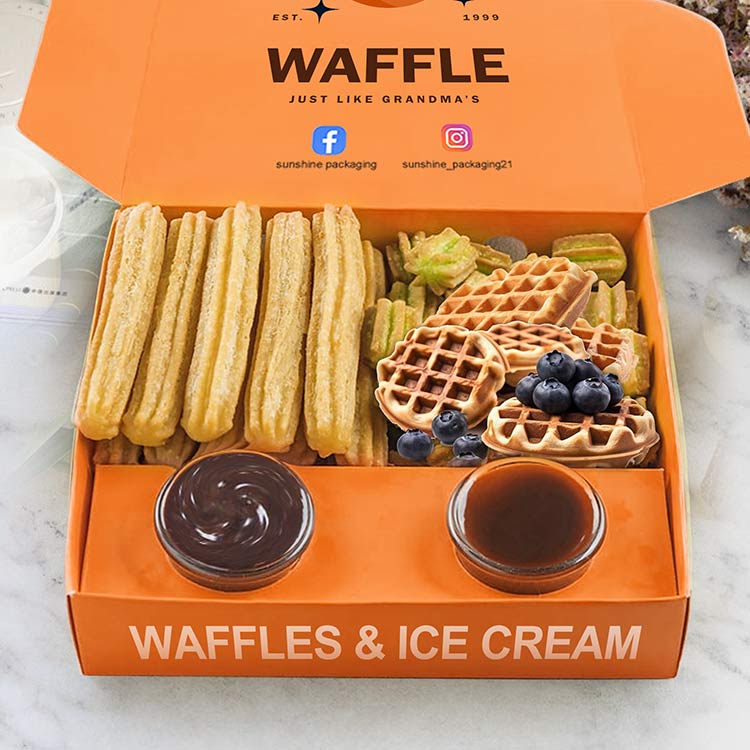Introduction

Catering boxes are essential for transporting, presenting, and serving food at events and functions. With many types of catering boxes to choose from, how do you select the right option for your catering needs? This guide explores popular catering box varieties, key factors to consider, customization opportunities, and tips for choosing the optimal catering packaging.
Main Types of Catering Boxes
There are several common categories of catering boxes, each with their own advantages:
Hinged Boxes
Hinged boxes have a lid attached with a crease or fold. They come in various shapes like rectangles, squares, and triangles. Hinged boxes allow single-handed access and anti-tamper security. They work for buffets, individual meals, and family-style platters.
Telescopic Boxes
Telescopic boxes feature stacking trays that slide inward, collapsing down. This saves space when not in use. Telescopic designs provide easy access from multiple sides and keep foods separated. They’re ideal for multi-course meals.
Boxes with Separate Lids
These boxes have detached, rigid lids that fully come off. They allow excellent visibility of contents. Different lid shapes like domes or boxes give variety. Access and ventilation is easy. They suit salads, shared appetizers, and desserts.
Compartment Boxes
Compartment boxes contain built-in dividers to separate foods. They keep ingredients from mixing and allow grouping by course or dish. Compartment boxes are efficient and organized for individual meals.
Display Boxes
Display options have clear sides and lids to showcase contents. They come in shapes like cylinders, cubes, and wedges. Display boxes let guests preview foods and highlight appealing presentation.
Key Considerations
When selecting catering boxes, keep these factors in mind:
- Type of food (hot, cold, liquid, etc.)
- Portion sizes and menu
- Single-serve or family-style
- Carrying and stacking needs
- Ambiance and presentation
- Branding and design
- Food safety
- Spill risks
- Waste reduction
- Budget
Match boxes to the practical needs while aligning with your desired aesthetic.
Customization Options

Standard catering boxes can be customized with:
Inner Configurations
Add protective liners, leak-proof barriers, air vents, elevated platforms, and compartments matched to dishes.
Outer Prints
feature colors, patterns, logos, and graphics aligned with your brand or event theme.
Shape and Size
Optimize dimensions and forms to your menu. Extend heights on boxes with tall elements.
Box Materials
Choose durable, leak-resistant, insulated, recyclable, or compostable materials.
Lid Styles
Pick detachable lids, slide tops, or fold-over flaps. Include clear sections for visibility.
Inserts and Accessories
Include serving utensils, decor elements, napkins, and condiments.
Sustainability
Use renewable materials, soy inks, non-toxic coatings, and recyclable components.
Picking Catering Box Suppliers
Key tips for selecting catering box suppliers:
- Review their experience with catering and food packaging.
- Inspect box quality firsthand with samples.
- Ask about lead times and minimum order quantities.
- Compare pricing for different quantities and options.
- Discuss how they can fulfill customization requests.
- Ensure they follow food safety regulations.
- Consider their sustainability practices.
- Check that they offer responsive customer service.
Conclusion
With an abundance of catering box varieties and customization choices, it’s important to align selections to your specific needs. Assess your menu, branding, recipients, transportation logistics, and budget. This will steer you towards ideal shapes, sizes, materials, and features. Partnering with an experienced catering packaging provider gives you access to specialized boxes that check practical and aesthetic boxes. Using the right catering boxes elevates presentation and protects your delectable foods in transit, making catering operations more seamless.
FAQ
What types of catering boxes are best for keeping food hot or cold?
For hot foods, cardboard and insulated plastic boxes with air vents work well. For cold foods, cardboard and solid plastic boxes maintain temperatures, as do insulated boxes with cooling gels or liners.
How do you determine the right size catering box?
Consider the portion size and shape of food items. Allow extra space for movement but minimize empty areas. Measure dishes and samples to gauge appropriate dimensions. Extend height for tall foods.
What are popular eco-friendly catering box materials?
Bamboo, recycled plastics and paper, plant-derived plastics, pulp, and bagasse are good sustainable options. Seek boxes with recyclable, renewable, or biodegradable components.
Should catering boxes be disposable or reusable?
Disposable boxes are more convenient and hygienic but generate waste. Reusable options are eco-friendly but require cleaning and retrieval. Evaluate costs and labor for reusables versus disposables.
What branding options are available for custom printed catering boxes?
Branding options include logos, patterns, fonts, colors, textures, and images. Printing techniques include lithography, flexography, screen and digital printing. Discuss possibilities with your box supplier.
